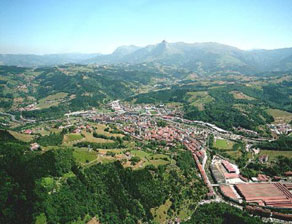Tourist and useful information

Touristic web-pages
Please visit http://tourism.euskadi.net/en/ (web-page is available on English, French, German, Portuguese, Russian, Chinese, Japanese, Spanish and Basque languages) or http://www.goierriturismo.com/en/ (web-page is available on French, Spanish, Catalan and Basque languages) to find all required information about Basque country.
Geographical location
Ordizia is located in the southern part of the province of Gipuzkoa, in the valley of the river Oria. Ordizia belongs to the region called Goierri and is composed of 18 municipalities. The heart of Ordizia is located in the centre of the village, slightly elevated over the left bank of the Oria river.
The main part of the village is organized around the old town. This part has an elliptical shape that reveals its origin from the Late Middle Ages. After the Carlist War the walls where demolished and the village grew around the old town. The industrial development of Beasain, Lazkao and also Ordizia blurred the demarcation of the three of them.
Ordizia is very well located as the main road, N-1, goes through the town. The RENFE railway line from Irun to Madrid also crosses it. Each 20 minutes there are trains to go to San Sebastian.
One of the most important aspects of Ordizia is its location, surrounded by two Natural Parks: Aizkorri-Aratz and Aralar. In Aralar we can climb Txindoki, the most beautifoul mountain in Gipuzkoa and in the other Natural Park we can climb the highest mountains in Gipuzkoa (more than 1500 metres).
Monuments - these are some of the most important monuments in Ordizia:
Palacio Barrena/Barrena Palace
A rambling house from the early 17th century built over an older house from which the flagstones of the hall are kept. It has been declared a Historical Monument.
Palacio de Zabala/Zabala Palace
A palace from the 16th century, made by Domingo the Zabala, who was an important character as he was Contador mayor del Reino (the kingdom's major accountant) who took part in the Battle of Lepanto against the Turkish.
Sculpture of Andrés de Urdaneta
The town council of Ordizia decided to build a statue in the honour of Andres de Urdaneta and decided to entrust the work to the sculptor Isidro Uribesalgo. In this image of the famous seafarer –maybe it is not the most representative of this brilliant man– we can see Urdaneta evangelizing the Indians in the Philippines. The bronze sculpture was made in Barcelona (5,000 kg.). Its base was made by Bonifacio Eguren with marble and stone from Mutriku.
Palacio de Abaria/Abaria Palace
Abaria Palace is a baroque palace dated from the 17th century and holds the name of the person who ordered it build, Francisco de Abaria.
Nuestra Sra de la Asunción church
This church is dedicated to the virgin Santa María de la Asunción. It was built on top of the remains of a primitive Romanesque church from the 13th or 14th century.
Sujetoenea
This is a building from the 18th century. It is thought to have been an inn and a stop-off for stagecoaches travelling in the Irun-Madrid line inaugurated early in the 17th century.
The town hall
This building was built between 1830 and 1832 on top of the foundations of the old Casa del Concejo (town hall). The style of the whole façade has been described as "Neogreekroman". On the upper part we can see the shield of Ordizia: a castle with three merlons.
Plaza Mayor (main square)
Plaza Mayor is the place where the weekly market is celebrated now and has been celebrated for many years. The covered structure was opened in 1925 with the project to cover the square awarded to Gurrutxaga, the well-known architect from Donostia. Carlos Mª Isidro swore the Charter of Gipuzkoa in this square.
D'elikatuz centre and tourist office
The D'elikatuz Centre is located at the Barretxe house and is one of the most important buildings in the old town. In the building you can also find the tourist office and two interpretive centres:
-
Interpretive Centre of the region of Goierri
Using audiovisual presentations, models, real material, pictures and computer support, the centre demonstrates the main features and elements of the region: art, history, nature, celebrations, traditions, etc.
-
Diet and Gastronomy Centre
At this centre, the main aspects of Basque country diet and nutrition are shown, which includes a commitment to a healthy diet and the value of local and typical products of the Basque Country.
